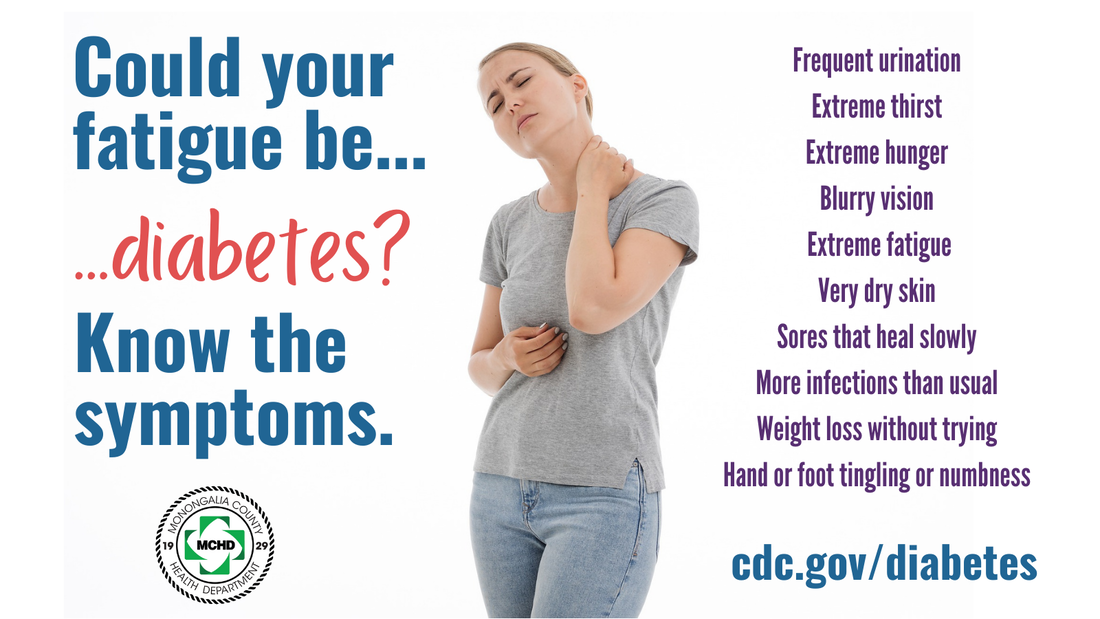Could your symptoms mean you have diabetes?

Nov. 4, 2020
By Peyton Azar
In the state of West Virginia, we experience the beauty of our beloved country roads, mountains, caverns and rivers. However, we also experience some things that are not so beautiful. Although known for our mountains and John Denver songs, our home is also known for leading the country in diabetes rates.
As of 2018, the Centers for Disease Control (CDC) reported that West Virginia had the highest diabetes death rate at 36.2%. And as of 2019, the United Health Foundation found that West Virginia was also the leading state in diabetes diagnoses.
With such alarming statistics, it’s crucial for West Virginians to become knowledgeable about the aspects of diabetes. November is American Diabetes Month, which is a great time to review this disease that affects so many people, many unknowingly.
Unfortunately, the symptoms of diabetes aren’t as well known as they should be. Because of this, many aren’t able to recognize their condition, leading to millions remaining undiagnosed.
In fact, the American Diabetes Association (ADA) estimates that more than 7 million Americans have undiagnosed diabetes. Even doctors can miss the symptoms of diabetes, which is exactly what happened to Jennifer, a Morgantown health care worker.
Several years ago, Jennifer began feeling incredibly lethargic. “My biggest complaint was fatigue. I was really tired. I was complaining to my physician, but I didn’t really get connected to testing for diabetes.”
It wasn’t until Jennifer began to think about how fatigued she felt 19 years ago when she had gestational diabetes, which is high blood sugar during pregnancy, that she thought to test her blood sugar.
Jennifer’s possible diabetes diagnosis became clear upon seeing her numbers. “I got a monitor at a drug store and tested my blood sugar. I thought, ‘This is not looking too good,” and realized this is why I was feeling so lousy.”
Although Jennifer’s main complaint was fatigue, there are various symptoms someone with diabetes can feel. The ADA lists the most common symptoms as being:
● Frequent urination
● Extreme fatigue
● Feeling very thirsty
● Increased hunger
● Blurry vision
● Slow healing of cuts and bruises
● Weight loss
● Tingling, pain, or numbness in the hands/feet
Jennifer’s discussed her blood sugar numbers with her primary physician, who discussed diet and exercise, which were lifestyle practices she thought she was already addressing.
“When see people their numbers and they aren’t moving the way we would expect, you assume that they are not following those lifestyle changes.”
Eventually, Jennifer realized she needed more specific guidance on nutrition, which she was able to get through the WVU Diabetes Education Center as well as an endocrinologist she was referred to by the Diabetes Education Center.
“The nutritionist looked at my food intake and was shocked. I was really not eating enough,” she said. “No one has ever said that to me in my entire lifetime. It slowed down my metabolism. That was a big change for me. I could eat more, but I definitely make healthy choices. I could eat more and improve my blood sugars along with medication.”
Another source Jennifer found greatly helped her was utilizing a FreeStyle Libre, a continuous glucose monitor. She details her positive experience with the device state, “Now I can get a good idea with how certain foods will trigger me, so you can really eat a meal and scan glucose monitor and track the sugars.”
There are several risk factors and causes for diabetes that people need to be aware of.
Type 1
Risk factors and causations for type 1 diabetes are much less understood than type 2. According the AD, type 1 diabetes is thought to occur when the body wrongfully attacks itself and doesn’t produce insulin. The CDC states that is often genetic and diagnosed in adolescence and young adulthood.
Type 2
The risk factors and causes for type 2 diabetes is much more understood. According to the ADA, type 2 diabetes occurs when the body is unable to product insulin correctly. The risk factors and causes are listed by the CDC as being:
● 45 or older
● Having family members with the disease
● Having prediabetes
● Little physical activity
● Having had gestational diabetes
● Being overweight
● Having non-alcoholic fatty liver disease
To prevent diabetes, the CDC states that it’s important to keep active, eat healthy and stay in a healthy weight range.
And also, be aware of diabetes symptoms and be willing to have a candid discussion with your physician if you begin to exhibit any of them. As Jennifer notes, if someone who already works in the health field can overlook, just about anyone can.
“Sometimes we really need to advocate for ourselves,” she said. “We know our body and know ourselves. I feel like I was doing things and it still wasn’t working. When I got to the specialist, that’s what they do. It was a big game changer for me it really was.”
Peyton Azar is an intern in the public information office at Monongalia County Health Department.